The current depression continues weather-wise, although I won’t let it get me down. The thought of another week of the same fills you with frustration though. But isn’t this just more of the same, and what we’ve come to expect?
We’ve had a superb fortnight of fruitful activity with a decent long spell of good weather, which makes it difficult to contend with the lows.
As superb as a summer of unbroken sunshine can seem, the realities are a climate such as ours cannot sustain long periods of hot, dry weather without consequences for us and more importantly for the insects, which in turn affect the whole eco-system.
This doesn’t of course satisfy the dragonfly enthusiast or photographer, but having witnessed two years of disappointments punctuated with days to remember, you learn to make the best of a situation.
So with this and the forecast in mind I waited until the clouds dispersed enough on Wednesday to allow a late glimmer of sunshine and made my weekly pilgrimage to my favourite pond.
Arriving at 3.30pm there was nothing immediately present across the water, but then the sun had yet to appear. A quick survey of the gorse thicket revealed male & female Broad-bodied Chaser, a fresh Four-spotted Chaser and, surprisingly, a fresh Common Darter. The latter unfortunately wouldn’t allow a photo.
When the sun did appear, so did the chasers across the pond, with Four-spotted battling and Broad-bodied pairing, mating and the female ovipositing shortly after.
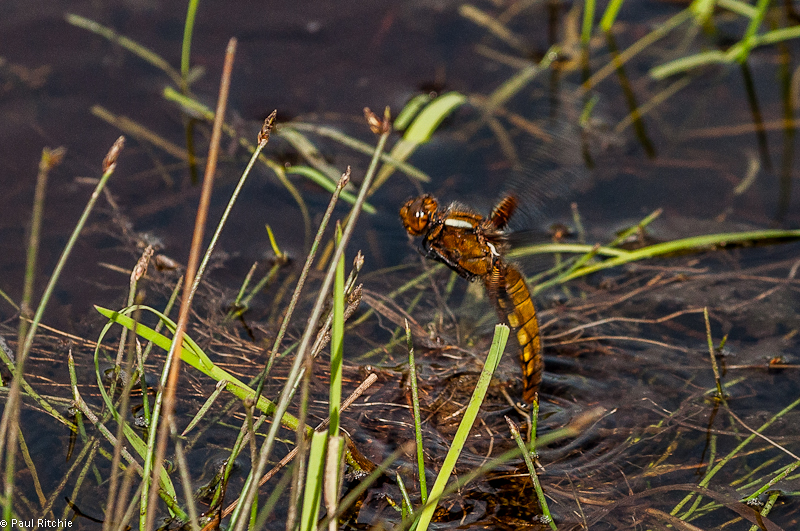
The male kept guard, rising occasionally to shoo off curious Four-spotted.
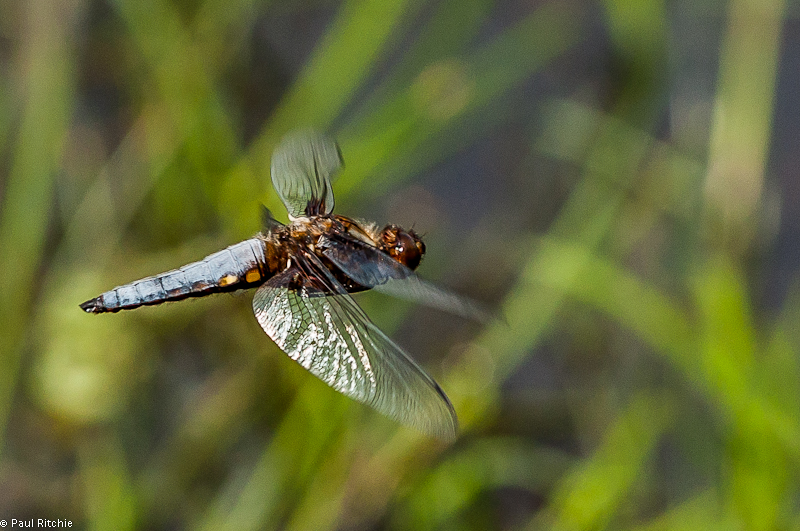
While I was watching this drama, I noticed the first damsels. Further circuits of the pond revealed Large Red, Azure, Common Blue and Blue-tailed damselflies, but only in one’s or two’s when on a good day there would be hundreds.
Activity over the pond continued while the sun shone, and after 5.00pm when the temperature started to drop the Broad-bodied perched up.
The Four-spotted continued to patrol and, realising that was probably it for the day, I decided to retire myself – but not before a lone male Downy Emerald made a late appearanace at 5.30pm.
He only stayed for 10 minutes, possibly warmed enough for a late afternoon hunt & snack, he circled me a few times before disappearing off with his prey.
When I first discovered this pond by accident 4 years ago while trekking through an area of the New Forest I hadn’t previously visited, it was one of those life-time moments. This was the very pond which turned me on to dragonflies.
So to see it provide a glimpse of that first encounter for (probably) the first time this year filled me with renewed hope that this season has yet to really start…
Thursday was a butterfly day. A yearly visit to Collard Hill in Somerset for the Large Blue. In typical fashion the first sighting were damsels sharing the same sheltered spot on the hill, far from water.

After I had my fill with the butterflies, I called in at Westhay Moor for a quick look. No dragons, but quite a few damsels laying up ready for the rain.
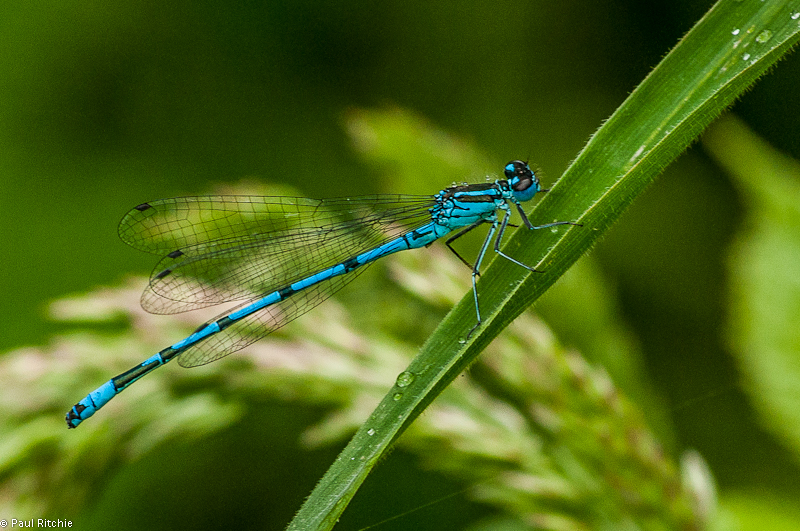
I took a rest on Friday to prepare for our weekend trip to Norfolk.
We arrived at Strumpshaw Fen just after noon on Saturday and did a full circuit in the horrendous wind. Very little shelter, but we did see several Four-spotted Chasers – the predominet species of the weekend, and towards the end of the walk our first Norfolk Hawkers!
No-one had told me they fly at the same speed and distance as Brown Hawkers! We had three fly-bys along the back stretch and also several sightings of Black-tailed Skimmers
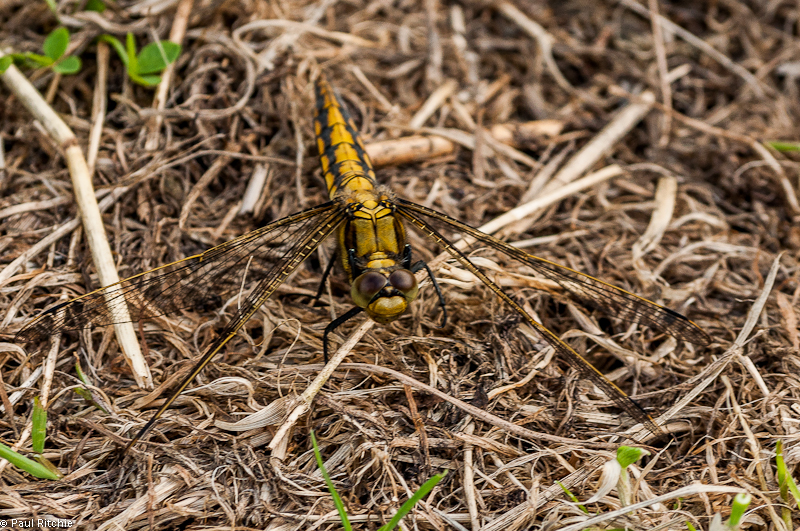
and Hairy Dragonflies.
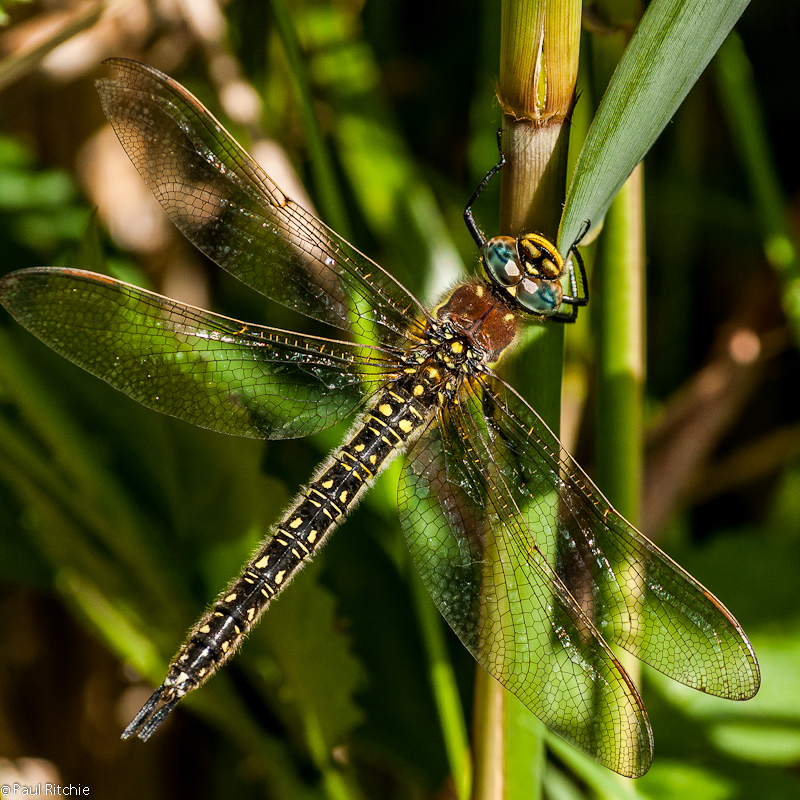
We decided to return to the only sheltered spot – a small, bright clearing along the woodland walk not far from the visitor centre.
More FSC’s and our first Broad-bodied Chaser seen that day.

Also in the same glade was a Scarce Chaser.
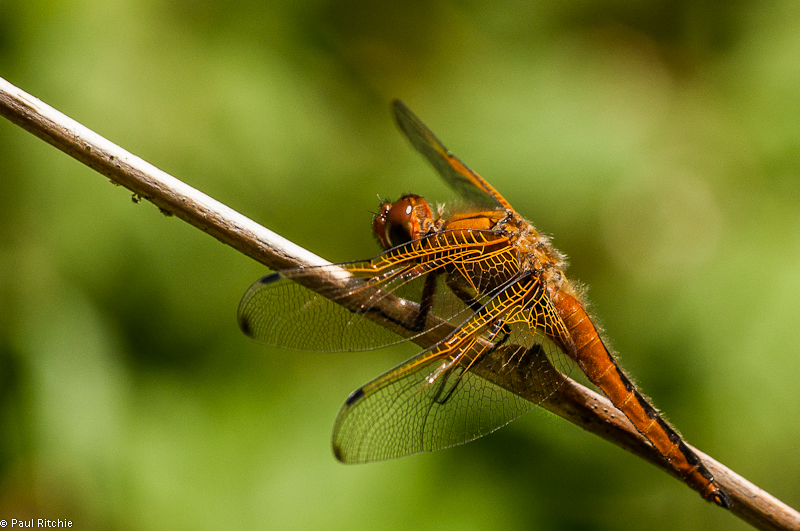
This glade seemed to be where all the late afternoon action was. A perfect grazing area for hungry dragonflies. Every now & again one would pop up from the perch to grab a passing snack, the greediest being a male Hairy.
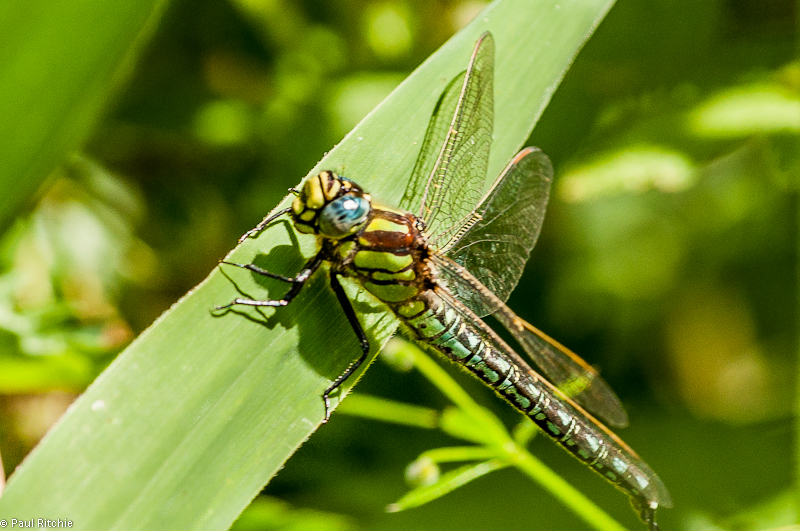
Then came the first highlight – possibly the best – of the weekend.
A female Norfolk Hawker appeared, flew straight towards us, hovered inches in front of Sue, then inches in front of me – close enough to look straight into her eyes.
And then she landed on my chin with her head resting on my bottom lip! It only lasted a couple of seconds, but such was the experience it felt like a couple of minutes.
Kissed by a dragonfly. It doesn’t get much better than that!
She continued flying around the clearing before disappearing low down and out of sight in inaccessible reeds. So no photo opportunity, but I ended the day on a real high.
On Sunday we headed over to Hickling Broad. The journey felt like a different country with quite possibly the best road-side verges I’ve seen on our mainland, full of Poppies and other wild flowers.
The traditional cottages, old lanes and peaceful water courses was a step back in time. I had no idea Norfolk could be so beautiful.
Unfortunately my mood was lowered on arrival at Hickling Broad. I can’t help feeling that a charge of £4.50 per adult for the Norfolk Wildlife Trust site is daylight robbery! That’s more expensive than the RSPB sites.
But I suppose it keeps the idiots away. However the rudeness and unhelpfulness of the chap at the visitor centre who only cared about taking our money put me in a foul mood.
It had better be worth it!
Luckily it was and my mood was soon lifted by our first ever sighting of a Swallowtail butterfly. This was soon followed by several more as the sun broke through. Truly an excellent sight to see them in flight, and even better to have them land close by to feed on Yellow Flag Iris.

No Norfolk Hawkers to be seen, but a fair number of Four-spotted Chasers, Black-tailed Skimmers and Hairys.
Next stop Upton Fen. Difficult to find and hidden away down a narrow lane, this location proved the best of the weekend. A magical place where you can follow the ditches which offer excellent views of the patrolling dragons and damsels.
Just inside the gate we had our second sighting that day of a Norfolk Hawker, the first being on the journey over hawking above a road-side verge.
This was another female hawking the ride and feeding on the wing before disappearing out of sight deep down in the reeds.
She rose a few times and even flew close to check us out. Again no photo opportunities, but I’m now convinced the (female) Norfolk beats the Southern hands down for curiosity!
By now Sue was getting anxious that I hadn’t managed a shot, so we continued exploring the fen and followed increasingly dodgy paths to gain access to the ditches.
Wellies are a must, but a bad wellie and sock combination the previous day resulted in a painful heat rash which prevented me from wearing anything other than a pair of light walking boots.
At one point Sue disappeared up to her knees in a hole!
It must’ve been a sign, because shortly afterwards I saw a male Norfolk Hawker appear along the ditch and land on the opposite bank. I couldn’t believe my luck!
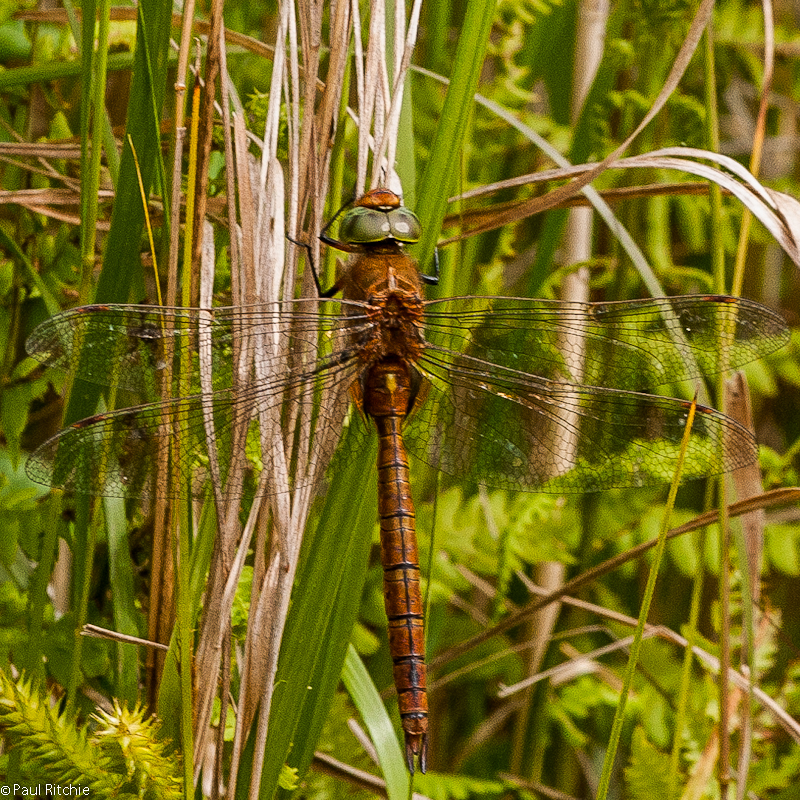
Perfect. My only photo opportinity the weekend, but one is all I need. Now I could relax.
We didn’t see any more until we returned to the car park where the female was still in attendance, but activity over the water was superb with more Four-spotted Chasers, Black-tailed Skimmers, Hairy Dragonflies and Azure, Large Red, Blue-tailed and Variable damselflies.
The surrounding reeds threw up several more photo opportunities for those plentiful Four-spotted Chasers.
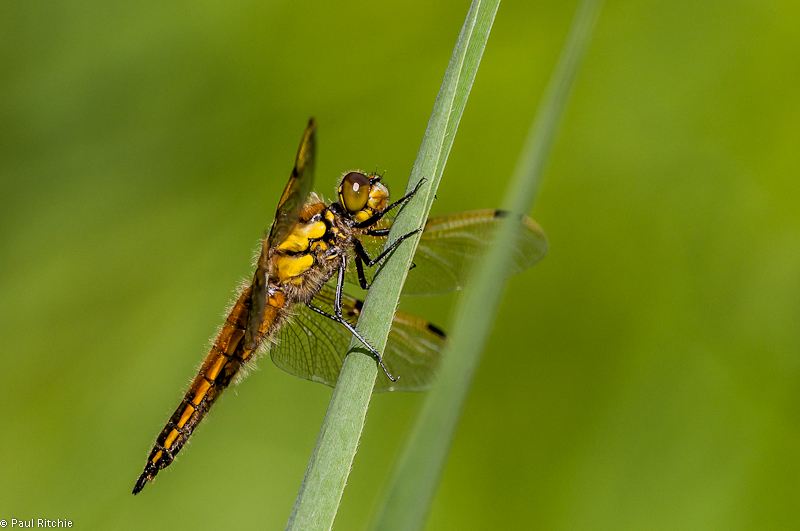
I could have stayed at the Upton Fen for the rest of the day, but time was moving on too quickly and we decided to call in at Strumpshaw once more on the way home. Just more of the same, damsels, FSC’s and Hairy’s, but at close to 6.00pm with the temperature dropping this was all we could expect.
So a fantastic and productive weekend which took a while to get going but produced the goods in the end with two more ‘lifers’ to add to my list.
If you’re thinking of visiting Norfolk in June, stop thinking and go for it. I will definitely be making this a yearly pilgrimage.
